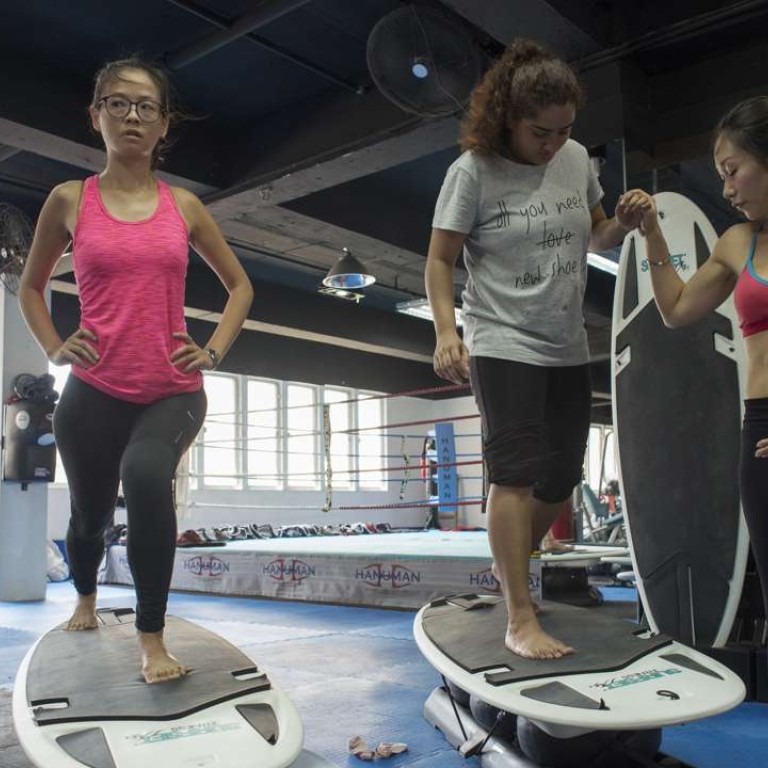
Indoor surfing: five ways to make the most of new Hong Kong fitness trend
Surfing joins skiing, baseball and car racing as indoor sports in space-challenged city. You can treat it as training for the real thing, but it also gives you a full-body workout like in a gym
Besides the great outdoors, sports enthusiasts have been flocking to old industrial buildings in the city for new ways to work up a sweat. Over the past few years, those sprawling industrial spaces have been converted into all kinds of sports venues, including ski slopes with real snow, a car racing track and a baseball diamond. The latest unconventional indoor sport: surfing.
While the waves are nowhere to be found at Surfset, the Hung Hom training centre has 11 surfboards, each supported by three rubber balls and two strings which mimic the wobbling surfers feel on the waves.

A novice with no experience in surfing, I joined a class last month led by instructor Cherilyn Chow, who is also Surfset’s managing director. While Chow struck all kinds of poses on the board with ease, I found it hard to balance. I try to stay upright by holding my stomach in. Keeping the soles of my feet and toes flush on the board also helps balance.
Chow says the most difficult thing for novices is to find balance on the board. The strings can be adjusted for different degrees of wobbling. “It takes four or five lessons to get used to the wobbling board. You have to keep your stomach in throughout the time you are on the board. If your core muscles are weak, you will have poor balance.”
The lessons at Surfset are divided into three categories: balance, burn and blend. Balance sessions include striking many yoga-inspired poses on the board. Burn consists of a series of movements resembling what surfers do on the waves to burn fat and strengthen your core muscles. This session is more intense, Chow says, involving non-stop cardio exercises like jumping and paddling, each lasting 30 seconds. Blend is a mixture of the balance and burn workouts.
Chow says doing the workouts can help surfers get the hang of the water sport faster. “A lot of real surfing is about balance as well. If learners practise balance well here, they will pick up surfing faster when they try it on the beach. But the sport is not only for surfers; it is a workout in itself. It can be intense training for losing weight and muscle strengthening. Some people install the Rip Surfer X, which costs HK$8,000, at home for training.”

“There’s no ocean. Paddling is a skill you need to know. You can’t learn how to catch the waves and how to position yourself in the ocean here. Also, in the ocean, there are many things to contend with like the waves and people. There are no such things here to handle.”
Paired with real surfing training, however, indoor surfing is a good complementary workout, Dickson says.
“Out at the sea, you have to paddle and do a pop-up to get on your feet – you need to have strength in the body to do that movement smoothly. When I teach beginners, I see lots of people who do not have core and back strength and they have trouble getting up [onto the board].
“Training at Surfset will definitely be a huge help in building adequate core, back, arm and leg strength that are critical to having control and being smooth when getting to your feet.”
Wondering what an indoor surfing workout involves? Here are some exercises done on the Rip Surfer X at Surfset.

1. Balance side plank
Lying on the board, turn onto the right side of your body and use your right hand to prop the body up. Straighten the legs and keep them together. Hold for 30 seconds and change sides.
Strengthens: arm, thigh, stomach and posterior muscles

2. Tree pose
Stand on the board. Balancing on your left leg, place your right foot on your left inner thigh with toes pointing downwards. Raise both arms above your head. Keep your core engaged. Change sides.
Strengthens: stomach, inner thigh and arm muscles

3. Paddle
Lie on the board face down. Lift chest and bend knees at 90 degrees with toes pointing up. Paddle with both hands.
Strengthens: back and shoulder muscles

4. Surf stance pop-up
From a prone position, jump to your feet to mimic riding a wave at sea. Crouch low by bending the knees, with your torso leaning slightly forward.
Strengthens: stomach and thigh muscles

5. Dips
Stand on one leg and use the other leg to paddle. Keep core engaged. Change legs.
Strengthens: calf, thigh and stomach muscles

